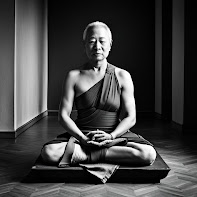Featured
- Get link
- Other Apps
Top 5 Buddhist Meditation Postures
Are you looking to deepen your meditation practice? Meditation is vital to any spiritual journey, no matter the specific faith and beliefs involved. Buddhist meditation is particularly advantageous for those seeking peace of mind — if we learn to control our thoughts, feelings, and identity, true inner peace can be found. To optimize your experience in Buddhist meditation postures, look at these top 5 popular stances used by both meditators or monks everywhere! Whether you're just starting or looking to switch up your routine, this guide will help show you which posture works best for your practice.
Lotus Posture – the most popular and iconic meditation posture
The Lotus Posture is undoubtedly the most popular and iconic meditation posture, as its significance and symbolism transcend cultures and religions worldwide. The posture is characterized by crossing one's legs and placing the feet on opposite thighs, with hands resting on the knees. The Lotus Posture is named after the lotus flower, known for its ability to grow and flourish in murky waters. Similarly, this posture gives the practitioner a sense of stability and groundedness, allowing them to delve deeper into their meditation practice. Although it may take some time to master, the benefits of the Lotus Posture make it a worthwhile endeavor for anyone looking to enhance their mental and spiritual well-being.
Half-Lotus Posture – similar to the lotus but with one leg crossed instead of both
The half-lotus posture has been practiced for centuries in yoga and meditation. This variation of the famous lotus posture is perfect for those who find it challenging to cross both legs. In this posture, one leg is crossed over the other, and the foot is gently placed on the opposite thigh. The half-lotus posture is beneficial for pranayama or breathing exercises, helping you to focus and calm your mind. By opening up the hips, this posture also increases flexibility in the lower body, improving the overall range of motion. Whether you are a seasoned yogi or a beginner, the half-lotus posture can be an excellent addition to your practice.
Seiza Posture – a kneeling position with feet tucked under the body
The Seiza posture, a traditional Japanese way of sitting, requires one to kneel with their legs and feet tucked under their body. This position is a sign of respect and mindfulness and, promotes good posture and strengthens the core muscles. Although it may seem uncomfortable initially, many people find that the Seiza position becomes more comfortable with practice and can be maintained for extended periods. Additionally, this posture is commonly used in martial arts and meditation practices, as it encourages deeper breathing and a calm, focused mindset. So, try the Seiza posture to improve your posture and engage in meditative practice!
Sitting in Chair Posture – a comfortable seated meditation posture in which you can sit on a chair or cushion
Burmese Posture – a cross-legged position with knees down on the floor and feet resting on top of each other
Burmese Posture, also known as Easy Pose within yoga practice, has been around for centuries. This cross-legged seating posture involves sitting with your knees on the floor and your feet resting on each other. While it may look simple, this pose requires flexibility and balance to be held comfortably. However, the benefits of assuming this posture are numerous. Not only does it encourage deep breathing and a clear mind, but it also helps to lengthen and align the spine. For those who spend long hours sitting at a desk or in a car, incorporating Burmese Posture into their routine can offer much-needed relief and a renewed sense of energy. So sit down, lift your chest, and take a deep breath in this grounding and peaceful pose.
After exploring the different meditation postures available, it's clear that there is something for everyone. Each of these postures has its benefits - with mindfulness and presence at the heart of all relaxation techniques. Remember that each body is unique, and it is vital to discover which position suits you best. Whether it's Lotus Posture, Seiza Posture, Sitting in Chair Posture, or Burmese Posture, practicing different postures and using your time in meditation wisely is beneficial. Listening to your body's needs can help us uncover the optimal state for a more profound meditation experience. Open yourself to all possibilities today, move through different postures, and quickly find which arrangement brings out your inner peace!



Comments
Post a Comment